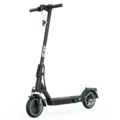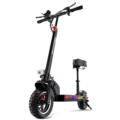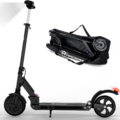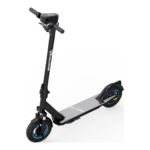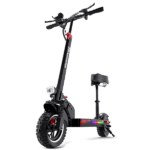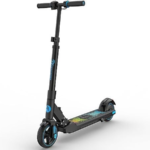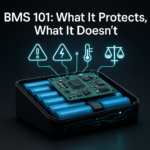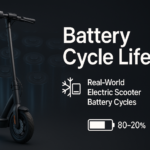- Home
- Scooters
- Electric Scooters
- EVERCROSS EV08S
EVERCROSS EV08S
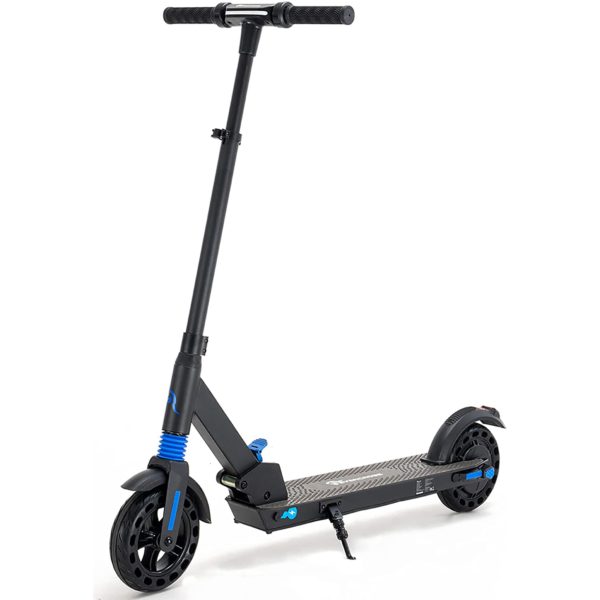

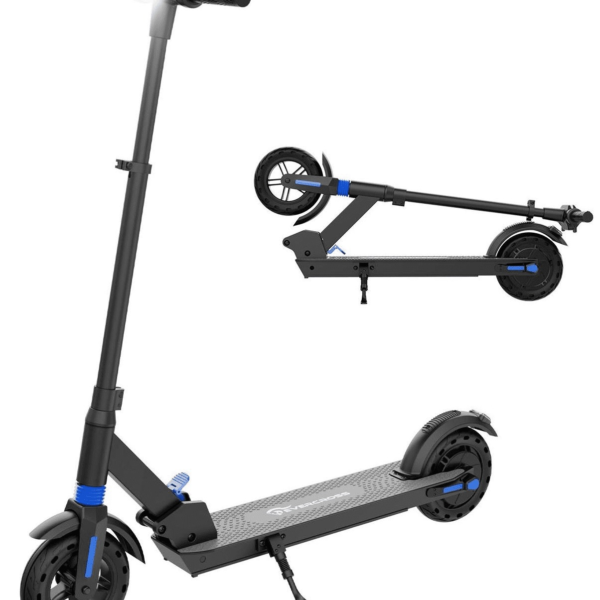
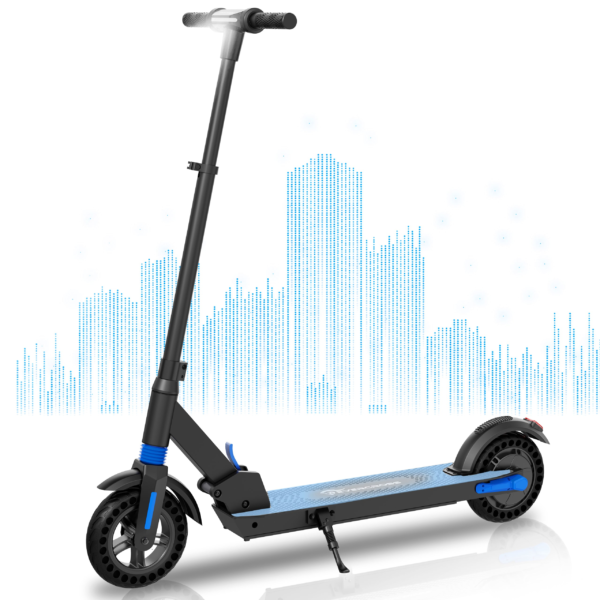
- Battery Range: 12–15 miles (20–25 km)
- Top Speed: 15.0 mph (24 km/h)
- Motor Power: 350 W
- Weight Capacity: 220 lb (100 kg)
- Charging Time: ~4–5 h
- Scooter Weight: 27.6 lb (12.5 kg)
PROS
- Lightweight 27.6 lb
- Compact fold (42.5×16.5×16.1 in)
- 8″ solid tires (puncture-proof)
- Dual braking (electronic + rear fender)
- IP54 rated
- Budget-friendly commuter
CONS
- No suspension
- Shorter range
- Basic lighting only
- Max load 220 lb may limit taller riders

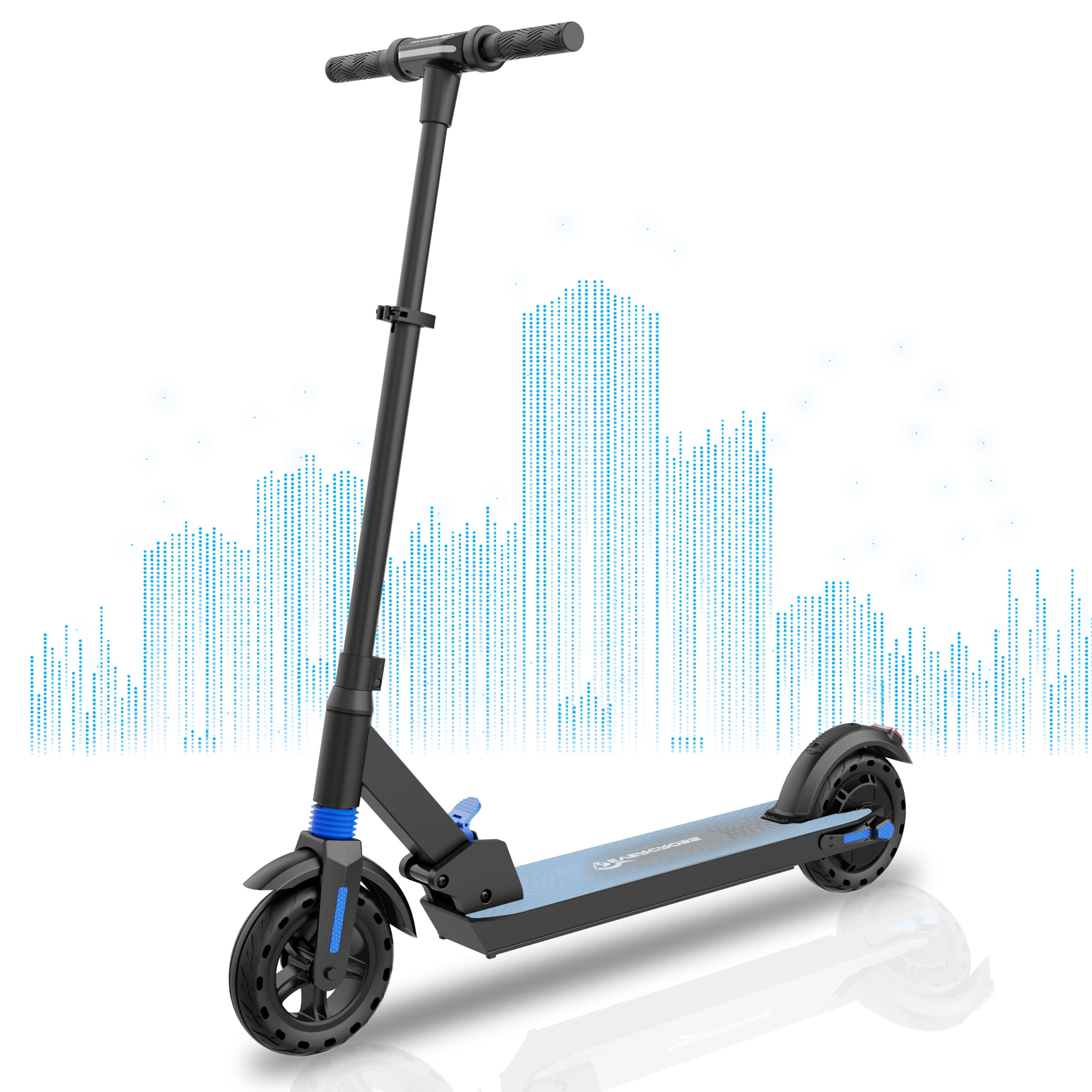
Table of contents
- What Is the EVERCROSS EV08S?
- How the EVERCROSS EV08S Works
- Key Specifications
- Design & Build Quality
- Performance Fundamentals
- Battery, Range & Efficiency
- Ride Quality & Comfort
- Braking & Safety Features
- Portability & Daily Usability
- Maintenance & Care
- Weather & Seasonal Considerations
- EVERCROSS EV08S vs Alternatives
- Who the EVERCROSS EV08S Is (and Isn’t) For
- FAQs
- Glossary
- Final Thoughts
The EVERCROSS EV08S is a compact, foldable urban scooter built around a 350W rear-hub motor and an efficient 36V system. It favors simplicity, low maintenance, and predictable handling over headline speed. Because it weighs about 27.6 lb (12.5 kg), it suits students, first-time riders, and last-mile commuters who want a reliable, easy scooter for short trips. Moreover, it balances range, portability, and control in a way that feels friendly from the first ride.
If you need a straightforward ride for daily errands or campus commutes, the EVERCROSS EV08S delivers a practical blend of power, range, and portability without fuss. Consequently, it becomes an easy daily choice when you want to ride more and tinker less.
What Is the EVERCROSS EV08S?
The EVERCROSS EV08S is a lightweight commuter scooter designed for paved paths and city streets. It pairs an entry-class 350W hub motor with 8-inch honeycomb (solid) tires, a simple cockpit, and a one-step folding mechanism. You get a rated top speed around 15 mph (24 km/h) and a rated range of about 12–15 miles (20–25 km), depending on rider weight, temperature, terrain, and how often you stop and start. As a result, it feels tuned for short, practical trips rather than long-distance adventures.
The frame is compact and the ergonomics are friendly to new riders. Step on, push off, and roll on the throttle. The deck is long enough for a natural stance, while the tall stem keeps the bars at a relaxed height for most riders between roughly 5’2″ and 6’0″ (157–183 cm). Furthermore, because the tires are solid, you won’t be dealing with flats; instead, you’ll feel a firmer road texture at low speed and a planted feel at cruise.
How the EVERCROSS EV08S Works
At its core, the EV08S is a simple electric drive system in a compact scooter chassis. Accordingly, each component plays a clear role:
- Motor: A 350W brushless DC hub motor sits in the rear wheel. Rear drive helps traction during starts, especially on gentle hills. You’ll feel a smooth push rather than a snap.
- Controller: The 36V controller meters battery power to the motor. As you pull the throttle, it increases duty cycle in controlled steps, which smooths acceleration and limits wheelspin on slick surfaces. Therefore, starts feel composed rather than abrupt.
- Battery: A 36V, 6Ah pack (216 Wh) powers the system. The pack includes protective battery management (BMS) to guard against overcharge, over-discharge, and short circuits. Expect a full charge in about 4–5 hours.
- Throttle: A trigger-style electronic throttle on the handlebar sends input to the controller. Hold a steady speed for a few seconds and, on most units, cruise control will maintain that pace until you touch the brake or throttle again. Consequently, longer straight sections feel effortless.
- Brakes: The system uses electronic braking (motor retardation) paired with a mechanical rear fender brake. The e-brake cuts motor power and applies gentle regenerative drag; pressing the rear fender adds mechanical stopping force. Together, they deliver controlled deceleration with minimal fuss.
Think of it like a simple, quiet, single-speed bicycle with an electric push: the motor handles forward motion, the controller is your “gearbox,” the battery is your fuel tank, and the brakes convert motion back into controlled slowdown. In practice, you ride, it does the rest.
Key Specifications
All values are presented US-first with metric equivalents in parentheses. These specifications reflect the typical EV08S configuration.
| Category | Item | Value |
|---|---|---|
| General | Model | EVERCROSS EV08S |
| Recommended Use | Urban commuting, campus, short-trip errands | |
| Net Weight | 27.6 lb (12.5 kg) | |
| Max Load | 220 lb (100 kg) | |
| Performance & Power | Motor | 350W brushless DC, rear hub |
| Top Speed (rated) | ~15 mph (24 km/h) | |
| Max Incline (rated) | ~15% | |
| Riding Modes | 3 speed modes (beginner to sport) | |
| Battery, Charging & Electrical | Battery | 36V 6Ah (216 Wh) |
| Charge Time | ~4–5 hours | |
| Charger | 42V output class, standard barrel-type connector | |
| Display | LED speed/gear/battery indicators | |
| Build & Dimensions | Tires | 8″ solid honeycomb (puncture-proof) |
| Unfolded Size | 41.3 × 16.5 × 42.5 in (105 × 42 × 108 cm) | |
| Folded Size | 42.5 × 16.5 × 16.1 in (108 × 42 × 41 cm) | |
| Frame | Aluminum alloy frame, steel and polymer components | |
| Safety & Control | Brakes | Electronic (E-ABS) + rear mechanical fender brake |
| Lights | Headlight and rear light with braking function | |
| Water Resistance | Splash-resistant design for light wet conditions; avoid heavy rain and standing water | |
| Features & Extras | Cruise Control | Yes (engages after steady throttle; cancel via brake/throttle) |
| Folding | One-step lever with locking latch | |
| Other | Kickstand, reflectors, basic bell | |
| Warranty & Compliance | Warranty | Manufacturer warranty (terms vary by region) |
| Returns | Typical 30-day return window (region dependent) | |
| Compliance | Standard micromobility compliance labeling; observe local riding laws |
Design & Build Quality
The EV08S looks and feels tidy. The frame uses aluminum alloy to balance stiffness with low weight. Welds and joints are clean, and the folding mechanism locks with a confident click. Because the stem is relatively slender, some flex is normal if you rock the bars at a standstill; under way, the structure feels composed up to its rated top speed. Even so, you should still keep bolts snug and the latch adjusted.
The deck is long enough to stagger your feet—one perpendicular, one angled—which helps weight distribution and steering stability. The cockpit keeps essential info front and center: speed, battery, and mode. The throttle throw is short, so inputs are light and precise. A simple bell and reflectors round out visibility and awareness. Additionally, cable routing stays neat, which reduces snags and rattles.
Fit-and-finish matters, especially on compact scooters. On the EV08S, the latch hardware sits flush, and the kickstand is easy to deploy. Solid honeycomb tires eliminate flats and reduce upkeep. In exchange, you feel more road texture through the stem and deck, especially on rough asphalt and pavers. Nevertheless, relaxed elbows and a staggered stance soften those impacts.
Performance Fundamentals
Acceleration Feel
From a stop, roll the throttle and the EV08S pulls with steady, predictable force. It won’t snap your head back; instead, it builds speed smoothly to around 10–12 mph (16–19 km/h), then eases toward the ~15 mph (24 km/h) ceiling. Because the motor is in the rear, traction off the line is better than front-hub scooters of similar power, especially on painted lines or damp patches. As a result, starts feel calm and confidence-building.
Cruising Stability
At a steady 12–15 mph (19–24 km/h), the chassis tracks straight with minimal wander. The solid tires lend a firm, connected feel; on smooth pavement, the ride is pleasantly quiet. On coarse chip seal, you’ll feel a fine buzz through the bars and deck; loosening your grip and bending your elbows helps absorb vibration. Moreover, choosing a middle riding mode often improves cruising smoothness.
Hill-Climb Behavior (~7–10% grades)
On short, moderate slopes (7–8%), the EV08S climbs acceptably if you carry a little momentum. Expect speed to taper as the grade continues; lighter riders maintain pace more easily. On steeper, longer ramps near 10%, plan to assist with a kick or approach in sport mode. Therefore, route planning matters if your commute includes sustained hills.
Battery, Range & Efficiency
Rated vs. Real-World
The 36V, 6Ah pack provides about 216 Wh of usable energy. The rated range is 12–15 miles (20–25 km). In mixed urban riding—frequent stops, a few short hills, cool weather around 50–60°F (10–16°C)—many riders should plan for 8–12 miles (13–19 km). Heavier riders, strong headwinds, and colder temperatures reduce range; smoother throttle use and lower speeds extend it. Consequently, gentle riding pays back in extra miles.
Factors That Matter
- Rider Weight: Closer to the 220 lb (100 kg) limit means more current draw and less range.
- Temperature: Lithium cells deliver fewer watt-hours in cold weather; warm the pack indoors before riding.
- Terrain & Stops: Hills and frequent start-stops drain energy faster than steady cruising.
- Speed: Aerodynamic drag rises with speed; cruising at 10–12 mph (16–19 km/h) increases efficiency.
Charging Best Practices
Use the included charger and allow 4–5 hours for a full charge from near empty. For battery longevity, avoid storing at 0% or 100% for weeks. If you’ll pause riding for a while, store the scooter around 50–70% charge in a cool, dry place. After wet rides, let the charge port and pack area dry before charging. In short, charge patiently and store thoughtfully.
Ride Quality & Comfort
The EV08S uses 8-inch solid honeycomb tires, chosen to eliminate flats. Solid tires add confidence on city debris, but they don’t cushion like air-filled tires. Consequently:
- On smooth asphalt, the ride is composed and quiet.
- On broken pavement, seams, and brick paths, you’ll feel more of the surface.
- Because the scooter lacks added suspension, your posture and tire footprint matter. Keep knees slightly bent, elbows relaxed, and feet staggered.
The handlebar width is moderate, which helps steering precision at low speed. Stem flex is modest in motion; riders often report a bit of spring when hitting sharp expansion joints. It’s normal for this class and dissipates quickly at cruise. Meanwhile, the short wheelbase aids quick turns in tight spaces.
Braking & Safety Features
The braking package combines electronic motor braking with a mechanical rear fender brake. The electronic system cuts power and adds controlled drag when you touch the lever or brake switch. For quicker stops, push down on the rear fender to add mechanical braking. Practice coordinated braking in a safe lot: apply electronic braking first, then add fender pressure smoothly. This technique shortens stops while keeping the chassis settled. Moreover, it reduces skids on smooth pavement.
Lighting is straightforward: a forward LED for visibility and a rear light that brightens under braking. Add reflective clothing at night and, if you ride often in the dark, consider a secondary helmet-mounted light to project where you look. The scooter’s splash-resistant design tolerates light dampness, but standing water is off-limits. However, traction drops dramatically on wet metal plates and paint—slow way down.
Portability & Daily Usability
At 27.6 lb (12.5 kg), the EV08S is easy to carry up a flight of stairs or onto a train. The one-step folding mechanism is quick: release the latch, lower the stem, and secure it to the rear hook. Folded, it measures 42.5 × 16.5 × 16.1 in (108 × 42 × 41 cm), which fits under many desks and into most car trunks. Therefore, it moves smoothly through multi-modal routines.
Daily users appreciate how little it asks of them. Solid tires mean no tubes, no pumps, and no patch kits. The deck cleans with a damp cloth. The charge port is easy to reach. Because the scooter is compact, you can park it beside a chair at a café or slide it into a closet. For security, use a U-lock or folding lock around fixed infrastructure where possible; never leave a folded scooter unattended outdoors. Additionally, label the frame discreetly for quick identification.
Maintenance & Care
A light, regular routine keeps the EV08S feeling crisp. Accordingly, this schedule works well:
- Before each ride (30 seconds):
Check for loose hardware at the stem latch, axle nuts, and handlebar clamp. Bounce the scooter gently; listen for rattles. Confirm both lights and the bell. - Weekly (5 minutes):
Wipe dust from the deck and around the charge port. Inspect the rear fender for alignment and brake actuation. Verify cables haven’t chafed at bends. Also, confirm the latch closes without grinding. - Monthly (10 minutes):
Inspect tire tread and edges for cuts. Check the latch bushing for play; apply a tiny drop of light oil to pivot points if they squeak. Verify the display buttons click cleanly. - Battery habits:
Avoid deep discharges to 0%. If storing more than two weeks, leave the pack near half charge and top up every 30–45 days. Likewise, avoid charging immediately after a hot ride.
Firmware is simple on this model; most units don’t require app updates. If your display has adjustable settings (speed limit, auto-sleep), set them once and revisit seasonally. Ultimately, simple checks prevent most issues.
Weather & Seasonal Considerations
- Rain: Treat the scooter as splash-resistant, not rain-proof. Slow down, double spacing to traffic, and avoid puddles deeper than the rim. Water can hide potholes that are harsh on solid tires. Additionally, dry the charge port before plugging in.
- Cold: Expect reduced range below ~50°F (10°C). Warm the battery indoors before charging and riding. Start your ride gently; cells perform better after a few minutes under light load.
- Heat: After hot rides, let the scooter cool before charging. Don’t store the pack in a parked car under direct sun.
- Traction: Painted lines, manhole covers, and wet leaves are slick. Brake early and upright. On damp days, downshift to a lower mode for smoother control. As always, visibility gear helps drivers see you sooner.
EVERCROSS EV08S vs Alternatives
Where the EV08S excels
- Simplicity: No air tubes, no complex suspension, and a basic brake pair make ownership easy.
- Portability: At under 30 lb, it’s manageable for stairs and transit.
- Predictability: Gentle acceleration, capped top speed, and steady handling lower the learning curve.
Where commuter/performance/off-road classes differ
- Commuter (larger wheels, 36–48V, 300–500W+): Smoother over rough pavement, typically longer range, sometimes pneumatic tires and a cable-actuated disc brake. They weigh more and cost more to maintain.
- Performance (dual motors, 52–72V): Explosive acceleration, 25–40+ mph (40–65+ km/h) capability, hydraulic brakes, and heavy frames. They demand experienced riders and frequent bolt checks.
- Off-road (knobby 10–11″, long-travel suspension): Great on trails and gravel, but bulkier, louder, and less convenient indoors.
If you outgrow the EV08S and want more headroom, consider the EVERCROSS EV10K Pro for a higher-spec commuter package. Alternatively, if you prefer similar lightweight simplicity with a different tuning, the EVERCROSS EV10Z is worth comparing.
Who the EVERCROSS EV08S Is (and Isn’t) For
Ideal for:
- Students crossing campus and city blocks.
- First-time riders who want a calm learning curve.
- Multi-modal commuters hopping between scooter, bus, and train.
- Urban errand-runners who value compact storage and quick folding.
Not ideal for:
- Long-distance commuters needing 20+ miles (32+ km) between charges.
- Riders on steep routes with extended 10% grades.
- Comfort-focused riders who prefer air tires and suspension for rough pavement.
- Speed seekers who want more than ~15 mph (24 km/h).
Therefore, match the scooter to your daily distance, your terrain, and your comfort preference.
FAQs
- What is the real-world range of the EVERCROSS EV08S?
Plan for 8–12 miles (13–19 km) in mixed city riding. Terrain, temperature, and rider weight affect results. In warmer, flatter conditions, expect more. - Does the EVERCROSS EV08S have cruise control?
Yes on most units. Hold a steady throttle for a few seconds to engage; tap brake or throttle to cancel. Consequently, long straight paths feel easier. - What tires come on the EV08S, and do they get flats?
It uses 8″ solid honeycomb tires. They don’t get punctures, but they ride firmer than air-filled tires. However, they reduce maintenance dramatically. - How steep of a hill can it climb?
Short 7–8% grades are manageable at reduced speed. On longer or steeper climbs near 10%, expect to help with a kick. Therefore, plan routes with hills in mind. - What’s included in this EVERCROSS EV08S overview that I should remember?
The essentials: 350W rear-hub motor, 36V 6Ah battery, ~15 mph (24 km/h) top speed, ~12–15 mi (20–25 km) rated range, solid 8″ tires, electronic + rear fender braking, and one-step folding. - Can I ride it in the rain?
It’s splash-resistant, not rain-proof. Avoid heavy rain, puddles, and standing water. Dry the charge port before charging. Additionally, slow earlier on painted lines. - What maintenance does it need?
Check latch hardware, lights, and brake function before rides. Wipe the deck weekly. Inspect tires and latch bushings monthly. Keep the battery between 50–70% if storing. Ultimately, small habits prevent big issues.
Glossary
- Ah (Amp-hours): Battery capacity rating; 6Ah means the pack can supply 6 amps for one hour under ideal conditions.
- Wh (Watt-hours): Total energy (volts × amp-hours). The EV08S has ~216 Wh (36V × 6Ah).
- Controller: The electronic unit that regulates power from the battery to the motor based on throttle input.
- BMS (Battery Management System): Circuitry that protects the battery from overcharge, over-discharge, short circuit, and thermal issues.
- Regen / Electronic Braking: Using the motor to slow the scooter by converting motion into controlled electrical resistance.
- Stem Flex: Slight elastic movement in the handlebar post when hitting bumps; normal in lightweight scooters.
- IP Rating: Ingress protection against dust/water. The EV08S is splash-resistant; avoid heavy rain and immersion.
- Honeycomb Tire: A solid tire with internal air channels that provide limited cushioning while resisting punctures.
- Riding Modes: Pre-set power/speed limits for beginner, normal, and sport riding.
- Kick Assist: A rider’s foot push to help starts or hills, reducing battery load.
- Duty Cycle: The controller’s fraction of “on” time versus “off” time when modulating motor power.
- Top Speed (Rated): Manufacturer-stated maximum speed on level ground with a typical rider and sufficient charge.
- Puncture-Proof: Tire design that eliminates inner tubes and air pressure, preventing traditional flats.
- Mechanical Brake: Physical brake (here, a rear fender friction device) that adds stopping force independent of the motor.
- One-Step Folding: A single-lever latch that lowers and locks the stem for carrying or storage.
- Specifications: The measurable details—motor power, battery size, and dimensions—that define performance and fit.
Final Thoughts
The EVERCROSS EV08S is a practical, low-maintenance scooter for short urban trips. It emphasizes predictable control, simple care, and quick folding. If your rides are compact and mostly flat, its 350W motor, 36V battery, and solid tires make daily mobility easy. Treat it kindly—avoid heavy rain, keep bolts snug, and charge thoughtfully—and it will return the favor with steady service. In the end, its specifications and manners align neatly with day-to-day city life.
Specifications
General
| Model The Model specifies the exact version or name of the scooter. It helps identify its unique design, features, and specifications within the manufacturer’s product line. Knowing the model makes it easier to compare options, find compatible accessories, or look up support information. | EV08S |
| Brand The Brand identifies the manufacturer or company that designs and produces the scooter. A trusted brand is a sign of quality, reliability, and good customer support. Well-known brands often have higher standards for safety, performance, and after-sales service, giving you more confidence in your purchase. | EVERCROSS |
| Release Date The Release Date indicates when the scooter model was officially launched on the market. This helps you know how current the design, technology, and features are. A newer release date often means updated components, improved performance, and the latest safety or smart features. | 17 November 2025 |
| Recommended Age Recommended Age indicates the minimum age range that the scooter is designed for, based on safety, size, and ease of use. Following the recommended age helps ensure that riders can handle the scooter’s speed, weight, and controls comfortably and safely. Always check local laws and use protective gear, especially for younger riders. | +16 |
Performance & Power
| Motor Power (Wattage) What it means: The motor power, measured in watts (W), shows how strong the scooter’s electric motor is. Why it matters: Higher wattage usually means better acceleration, more torque, and improved performance on hills or rough terrain. For example, a 250W motor is good for flat city roads and light riders, while a 500W or 1000W motor provides more power for faster speeds or climbing steep inclines. | 350 W rear hub motor |
| Top Speed The Top Speed indicates the maximum speed that the scooter can reach under optimal conditions. It’s usually measured on level ground with a fully charged battery and an average rider weight. A higher top speed allows you to travel longer distances faster, but always ensure you ride within legal speed limits and your personal comfort zone for safety. | 15.0 mph (24 km/h) |
| Battery Capacity Battery Capacity refers to the total amount of energy the scooter’s battery can store, usually measured in ampere-hours (Ah) or watt-hours (Wh). A higher battery capacity means you can ride longer distances on a single charge, reducing the need for frequent recharging. Keep in mind that actual range can vary depending on rider weight, terrain, speed, and weather conditions. | 36 V 6 Ah (216 Wh) |
| Estimated Range per Charge The Estimated Range per Charge indicates the average distance the scooter can travel on a single full battery charge. This range is calculated under optimal conditions, such as flat terrain, moderate speed, and average rider weight. Real-world range may vary depending on riding style, terrain, weather, and load. A longer range means fewer recharges and greater freedom for longer trips. | 12–15 miles (20–25 km) |
| Hill Climb Ability Hill Climb Ability describes the maximum incline or slope that the scooter can handle while maintaining stable performance. It’s typically expressed as a percentage or in degrees. A higher hill climb rating means the scooter can tackle steeper hills without losing too much speed or power. Actual climbing performance may vary based on rider weight, battery charge, and terrain conditions. | Up to 15% grade |
| Drive System The Drive System refers to how power from the motor is delivered to the wheels. Electric scooters typically use either a hub motor (directly integrated into the wheel) or a chain/belt drive system. A high-quality drive system ensures smooth acceleration, efficient power transfer, and low maintenance. The choice of drive system affects performance, noise level, and overall ride experience. | Rear hub (RWD) |
Charging & Electrical
| Charging Time Charging Time indicates how long it takes to fully recharge the scooter’s battery from empty to 100% using the standard charger provided. Faster charging means less downtime and more time on the road. Actual charging time may vary slightly depending on battery capacity, charger output, and environmental conditions. | Approx. 4–5 hours |
| Battery Type Battery Type refers to the specific technology used in the scooter’s battery, which affects performance, lifespan, weight, and charging time. Most modern electric scooters use high-quality lithium-ion (Li-ion) batteries because they offer a good balance of energy density, durability, and low maintenance. A reliable battery type ensures consistent power delivery and longer riding ranges. | Lithium-ion pack |
| Removable Battery A Removable Battery means the battery pack can be easily detached from the scooter for convenient charging and replacement. This feature allows you to charge the battery separately, swap it with a spare for extended range, or securely store it indoors in extreme weather. Removable batteries add flexibility and make it easier to keep your scooter powered up wherever you are. | Non-removable internal battery |
| Regenerative Braking Regenerative Braking is an energy-saving feature that converts some of the energy normally lost during braking back into battery power. When you slow down or brake, the motor works in reverse to generate electricity, which helps extend the scooter’s range and improves overall efficiency. This system also reduces wear on traditional brake components, leading to lower maintenance over time. | Yes (via electronic brake) |
| Lighting Lighting refers to the built-in front and rear lights that enhance visibility and safety when riding in low-light conditions or at night. Good lighting helps you see the road ahead and ensures that other road users can see you. Many scooters include LED headlights, taillights, and sometimes brake lights or side reflectors for added safety and compliance with local traffic regulations. | LED headlight + rear LED/brake |
Build & Dimensions
| Scooter Weight Scooter Weight refers to the total weight of the scooter when fully assembled, including the battery. This affects how easy it is to carry, lift, and store the scooter when not in use. A lighter scooter is more portable and convenient for commuting, especially if you need to carry it upstairs or onto public transport. Keep in mind that a sturdy frame and quality components may add to the weight but also contribute to better durability and ride stability. | 27.6 lb (12.5 kg) |
| Maximum Rider Weight Maximum Rider Weight indicates the highest rider weight that the scooter is designed to safely support while maintaining optimal performance and stability. Staying within this limit helps ensure reliable acceleration, braking, and climbing ability, and it protects the frame, suspension, and motor from excessive strain. Exceeding the recommended limit may reduce performance and increase wear on components. | 220 lb (100 kg) |
| Deck Size Deck Size refers to the dimensions of the scooter’s standing platform. A wider and longer deck provides more foot space, allowing you to stand comfortably and adjust your stance while riding. A well-sized deck improves balance and stability, especially on longer rides or at higher speeds. Compact decks, on the other hand, help keep the scooter lightweight and portable. | Slim deck; easy carry |
| Handlebar Height Handlebar Height refers to the distance from the deck to the handlebars, which affects your riding posture and comfort. An appropriate handlebar height helps you maintain good balance, reduces strain on your back and arms, and makes steering more comfortable. Some scooters have adjustable handlebars to fit riders of different heights, while others have a fixed height for a streamlined design. | Fixed |
| Folding Mechanism The Folding Mechanism describes how easily and securely the scooter can be folded for carrying and storage. A well-designed folding system lets you quickly collapse the scooter into a compact size, making it convenient to transport on public transit, store under a desk, or fit into a car trunk. Look for sturdy latches and safety locks to ensure the scooter stays firmly in place when folded or unfolded. | Quick fold latch |
| Dimensions Folded Dimensions indicate the size of the scooter when it’s fully folded. This measurement shows how much space the scooter will take up when stored or carried, making it easier to check if it will fit in your car trunk, under a desk, or in a closet. Compact folded dimensions are ideal for commuters who need to bring their scooter on public transport or store it in tight spaces. | Unfolded: 41.3×16.5×42.5 in (105×42×108 cm); Folded: 42.5×16.5×16.1 in (108×42×41 cm) |
| Material Material refers to the primary construction materials used for the scooter’s frame and key components. High-quality materials like aircraft-grade aluminum, reinforced steel, or durable composites provide strength, stability, and a lighter overall weight. A sturdy material ensures the scooter can handle daily wear and tear while maintaining safety and performance. | Aluminum alloy |
Safety & Control
| Brake Type(s) Brake Type(s) describe the braking systems the scooter uses to help you slow down or stop safely. Common brake types include mechanical brakes (like drum or disc brakes), electronic brakes, and foot brakes. Many scooters combine multiple braking systems for added safety and shorter stopping distances. The type and quality of brakes affect your control, especially when riding at higher speeds or on slopes. | Front electronic + rear foot brake |
| Suspension Suspension refers to the system that absorbs shocks and vibrations while riding, providing a smoother and more comfortable ride over uneven or rough surfaces. Scooters may have front suspension, rear suspension, or dual suspension for better shock absorption and stability. Good suspension helps reduce rider fatigue and improves control, especially when riding on bumpy roads or off-road paths. | None |
| Tire Type Tire Type refers to the kind of tires the scooter uses, which directly affects ride comfort, traction, and maintenance. Common types include solid (airless) tires, pneumatic (air-filled) tires, or hybrid options. Pneumatic tires offer better shock absorption and a smoother ride on rough surfaces, while solid tires are puncture-proof and require less upkeep. The right tire type helps ensure safe handling and a comfortable ride in different conditions. | 8″ solid tires |
| Tire Size Tire Size indicates the diameter and width of the scooter’s tires, which affect ride comfort, stability, and how well the scooter handles different terrains. Larger tires generally offer better shock absorption and a smoother ride over bumps and rough surfaces, while smaller tires keep the scooter lighter and more portable. Choosing the right tire size helps ensure a balance between agility and comfort. | 8-inch |
| Kickstand The Kickstand is a built-in stand that allows you to park your scooter upright when it’s not in use. A sturdy kickstand keeps the scooter stable and prevents it from tipping over, protecting it from scratches and damage. It also makes storing and accessing your scooter more convenient, whether you’re at home, work, or on the go. | Side kickstand |
| Water Resistance Rating Water Resistance Rating indicates how well the scooter is protected against water and moisture, usually shown as an IP (Ingress Protection) rating. This rating helps you understand whether the scooter can handle light rain, splashes, or wet roads without damage. While most scooters are not fully waterproof, a good water resistance rating adds peace of mind when riding in changing weather conditions. Always avoid deep puddles or submerging the scooter to protect its electrical components. | IP54 |
Features & Extras
| Display/Console The Display (or Console) shows important real-time information about your ride, helping you monitor your scooter’s status at a glance. Typical displays show speed, battery level, distance traveled, and riding mode. Some models also include additional features like Bluetooth connectivity, app integration, or backlighting for better visibility at night. A clear and easy-to-read display enhances safety and convenience on every trip. | LED display (speed, battery) |
| Ride Modes Ride Modes refer to the different speed and power settings you can choose to match your riding style or road conditions. Common modes include eco for maximum range and energy efficiency, standard for everyday balance, and sport or turbo for higher speed and stronger acceleration. Switching between ride modes allows you to customize performance, conserve battery, and ride safely in various environments. | 3 modes (Eco/Drive/Sport) |
| Smart App Connectivity Smart App Connectivity lets you pair your scooter with a dedicated mobile app via Bluetooth. Using the app, you can monitor real-time ride stats like speed, battery level, and range, adjust settings such as ride modes or cruise control, lock the scooter for added security, and sometimes receive firmware updates. This feature adds convenience and allows you to personalize your riding experience right from your smartphone. | No app |
| Anti-Theft System The Anti-Theft System helps protect your scooter from unauthorized use or theft. This feature can include built-in alarms, electronic motor locks, GPS tracking, or remote locking through a mobile app. A good anti-theft system provides peace of mind when parking your scooter in public spaces, adding an extra layer of security to safeguard your investment. | — |
| Cruise Control Cruise Control allows you to maintain a steady speed without continuously holding the throttle. This feature makes longer rides more comfortable by reducing hand fatigue and providing a smoother, more relaxed riding experience — especially on flat, open roads or bike lanes. For safety, cruise control can usually be easily activated or deactivated while riding. | Yes (cruise control) |
| Accessories Included Accessories Included lists the additional items that come with the scooter to enhance your riding experience and convenience. Common accessories may include a charger, kickstand, bell, lights, phone holder, or carrying strap. These extras add value by making your scooter safer, easier to use, and ready to ride straight out of the box. | Scooter, charger (~42V 1.5–2A), tools, manual |
Warranty & Compliance
| Warranty Period The Warranty Period indicates how long the manufacturer guarantees the scooter against defects in materials and workmanship under normal use. A good warranty provides peace of mind, showing the brand’s confidence in its product quality. Always check what parts are covered, such as the frame, battery, and motor, and follow the maintenance guidelines to keep your warranty valid. | Region-dependent |
| Certifications Certifications confirm that the scooter meets specific safety, quality, and environmental standards set by recognized organizations or regulatory bodies. Common certifications may include CE, RoHS, UL, or other local compliance marks, depending on your region. These certifications ensure that the scooter is manufactured to high standards and is safe and legal to use in your country. | Local micromobility rules apply |
Price Comparison




